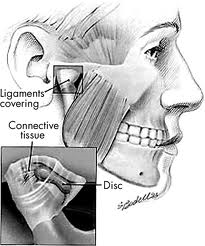I first became interested in the mechanics of the jaw and the TMJ (temporomandibular joint) when I began to suffer from tension, restricted range of movement and clicking in my own jaw. I think it was a combination of starting up my own business, having a baby and having to cope with a lot of stress and change that created my ongoing jaw troubles. A bad habit can be created so quickly. Clenching, grinding and setting our jaw is such a common habit experienced by so many people. Over time I have come to realise that this habit can stem from many things but I think the most common cause is stress.
The TMJ i s one of the most used joints in our body. It is worked when we talk, chew, swallow, kiss, yawn – and these are just the obvious movements. The TMJ is where the lower jaw, the mandible, joins the temporal bone of the skull. It is a sliding ball and socket joint which has a disc sandwiched between it and has a cartilage lining. You can locate the joint by pressing your fingers gently in front of each ear and then opening and closing your mouth. You should feel the joint in motion. If it is tender or painful this indicates you have a disorder or imbalance of the TMJ. Most symptoms of a TMJ disorder are noticed away from the joint. You can experience headaches or migraines, ear aches, dizziness, ringing in the ear (tinnitus), facial, neck and shoulder pain. You often find it difficult to open the mouth wide and feel a clicking of the joint. Approximately 40% of nerves leave the brain via the TMJ, including the trigeminal nerve. Any restriction of the nerves can cause many different health problems. TMJ stability is very reliant on the balance of the muscles surrounding the joint. There are many different behaviours or conditions which can cause a problem to this area such as:
s one of the most used joints in our body. It is worked when we talk, chew, swallow, kiss, yawn – and these are just the obvious movements. The TMJ is where the lower jaw, the mandible, joins the temporal bone of the skull. It is a sliding ball and socket joint which has a disc sandwiched between it and has a cartilage lining. You can locate the joint by pressing your fingers gently in front of each ear and then opening and closing your mouth. You should feel the joint in motion. If it is tender or painful this indicates you have a disorder or imbalance of the TMJ. Most symptoms of a TMJ disorder are noticed away from the joint. You can experience headaches or migraines, ear aches, dizziness, ringing in the ear (tinnitus), facial, neck and shoulder pain. You often find it difficult to open the mouth wide and feel a clicking of the joint. Approximately 40% of nerves leave the brain via the TMJ, including the trigeminal nerve. Any restriction of the nerves can cause many different health problems. TMJ stability is very reliant on the balance of the muscles surrounding the joint. There are many different behaviours or conditions which can cause a problem to this area such as:
- Grinding or clenching your teeth

- Chewing gum or your nails frequently
- Dental problems or misalignment of your teeth
- Whiplash
- Bad posture when working at your desk
- Trauma to the jaw ie. Fractures
When one suffers from a TMJ imbalance it can be a tricky thing to fix but thankfully there are things you can do which will make such a difference. The first thing to do is to practice awareness. Go through your day and notice if you are unconsciously clenching or grinding your jaw. Practice creating space between your teeth to help relax the muscles of your face. Avoid food that is a workout for your jaw or makes you open your mouth wide. Try and rest your jaw.
Look at how to manage your stress. There are so many wonderful ways to approach this like yoga, counselling, massage, rest, having some fun…the list goes on. Bowen Therapy is an excellent form of treatment for the TMJ. I have seen its positive affects over and over again. It can effectively relieve spasm and inflammation in the related muscles, tendons and nerves around the joint. It can also correct any misalignment and help us drop the habit of tensing the jaw. Because of the complexity of TMJ disorders, Kinesiology is another great tool to help unravel the mystery and help you realise the causes of the imbalance. In many cases, it is an emotional or mental conflict which needs to be faced. If you suspect you may suffer from a TMJ imbalance it is worth getting treatment.
Noticeable change can happen within 1 to 2 sessions. It will make such a difference to so many aspects of your life. It’s amazing how life opens up when we are no longer experiencing dull headaches and pain in the body. Dealing with pain and discomfort takes a lot of energy.
Billie is a Bowen Therapist and Kinesiologist and has a keen interest in treating upper body and TMJ imbalances. She is available for treatments at Kundalini House on Thursdays.
Please rate this wake up world post using the stars below. Your ratings will provide us a better understanding of topics that are important to our readers. We also wish to thank everyone for their continued support of Kundalini House and the Kundalini Houses Blog. Sat Nam.







Leave A Comment